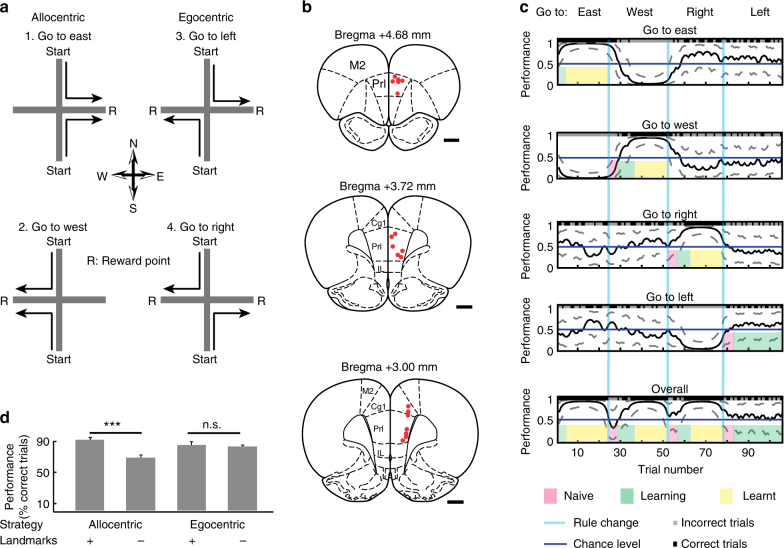Fig. 1.
Strategy-switching task and behavioural analysis. a Rats were placed randomly at one of the two possible start positions during consecutive trials. On the basis of landmark-referenced (allocentric strategy, rules: 1, 2) or self-referenced (egocentric strategy, rules: 3, 4) navigation, the animal has to travel on a plus-maze in order to receive reward (R). After the rat makes 13 correct choices within 15 consecutive trials, the rule is changed unannounced to the animal. b Position of the recording sites (n = 19, number of rats = 3) in the prelimbic and cingulate cortex indicated by red dots in three different coronal sections of the prefrontal cortex. Scale bars, 1 mm. c Task performance of a behavioural session was evaluated using the binary data of behavioural choices (correct choice: black, incorrect choice: grey) via a Markov-chain Monte–Carlo analysis35 which provides a confidence interval for each trial. By thresholding the performance score of the lowest confidence interval in any of the learning curves (go east, go west, go to right or go to left) corresponding to different rules, three different behavioural phases were assigned to each trial: naive (below 0.1 for reversals and 0.3 for switches); learning (between 0.1 and 0.6 for reversals and 0.3–0.6 for switches); and learnt (over 0.6). d Task-performance during control experiments when landmarks on surrounding walls were removed or maintained during allocentric (n = 11) or egocentric (n = 13) strategies. Keeping the landmarks during allocentric strategies (n = 12 tests; performance = 90 3.015 %; data are mean SEM), removing the landmarks during allocentric strategies (n = 11, performance = 68 3.71 %), keeping the landmarks during egocentric strategies (n = 12, performance = 83 4.14 %) and removing the landmarks during egocentric strategies (n = 13, performance = 81 1.91%). Note that only the removal of landmarks during allocentric strategies resulted in a reduced task performance (Wilcoxon rank-sum test). *** indicates p < 0.001, N.S. indicates no significant. Error bars, s.e.m

